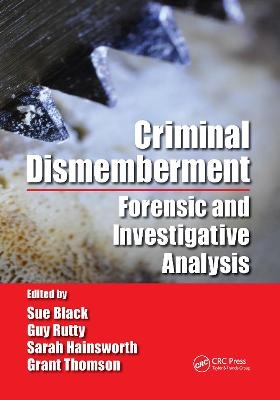
Criminal Dismemberment
CRC Press (Verlag)
978-0-367-77838-5 (ISBN)
Criminal Dismemberment is the first book to examine dismemberment as a phenomenon in the context of criminal acts. While the number of such dismemberment cases in any given country is often small, the notion of dismemberment captures the imagination, often leading many to question the motivations as to why anyone would perpetrate such an unnatural act.
The act of dismemberment, in its original form, referred to cutting, tearing, pulling, wrenching or otherwise separating the limbs from a living being as a form a capital punishment. In today’s society, it has become associated most frequently with the criminal act of sectioning the remains of the dead in an attempt to conceal the death and dispose of the remains or make the process of identification of the deceased more difficult to achieve.
Drawing on expertise from leading forensic anthropologists, pathologists, and forensic materials engineers, the book brings together much of the literature on criminal dismemberment—viewing it from the investigative, forensic, and social science perspectives. Key features include:
Psychological analysis of the perpetrator
Detailed examination of case studies, anonymized from recent investigations
Difficulties encountered in a dismemberment investigation
Tool mark analysis, including knives and saws, accompanied by over 120 detailed, full-color illustrations and photographs
Serves as a unique and useful resource in the investigation of dismembered human remains
The diverse backgrounds of the contributors offers a thorough account of such topics as the history of dismemberment, the forensic pathology in such cases, the importance of developing a common vocabulary in terminology used, the legal admissibility in dismemberment cases. As such, Criminal Dismemberment will serve as a comprehensive reference for students and practitioners alike.
Professor Dame Sue Black is a Professor of Anatomy and Forensic Anthropology, the Director of the Centre for Anatomy and Human Identification and the Director of the Leverhulme Research Centre for Forensic Science at the University of Dundee, UK. Professor Guy Rutty is a Home Office registered Forensic Pathologist and is the vicechair of the International Society of Forensic Radiology and Imaging, University of Leicester, UK. Professor Sarah Hainsworth is a Professor of Materials and Forensic Engineering, University of Leicester, UK. Mr. Grant Thomson is a former Scenes of Crime Officer and Crime Scene Manager. He is currently a senior trainer and consultant in capacity building within fragile and conflict affected states.
Preface
Chapter One: Introduction to Criminal Human Dismemberment
Sue Black, Guy Rutty, Sarah Hainsworth and Grant Thomson
Chapter Two: Dismemberment: An Historical Perspective
Shane McCorristine
Chapter Three: Psychology and Dismemberment
David Holmes
Chapter Four: Mr Adam Vincent, Humberside Police
Mark Oliver
Chapter Five: Miss Gemma McCluskie, Metropolitan Police Service
John Nicholson
Chapter Six: Terminology
Sue Black and Grant Thomson
Chapter Seven: Principles of Tool Mark Analysis and Evidential Best Practice
Grant Thomson and Sue Black
Chapter Eight: Overview of the Examination of a Dismembered Body
Guy Rutty and Bruno Morgan
Chapter Nine: The Role of Forensic Anthropology in Cases of Dismemberment
Lucina Hackman and Sue Black
Chapter Ten: Identification Marks – Saws
S. V. Hainsworth
Chapter Eleven: Identification Marks – Knives and Other Implements
S. V. Hainsworth
Chapter Twelve: Future Research in the Analysis of Criminal Dismemberment
S. Black, N. Nic Daéid, L. Hackman and G. Thomson
Appendix 1: Additional Investigative Resources
S. Baylis and G. S. Thomson
Appendix 2: Known Cases of Criminal Dismemberment in the UK Since 1985
Sue Black
| Erscheinungsdatum | 06.04.2021 |
|---|---|
| Verlagsort | London |
| Sprache | englisch |
| Maße | 178 x 254 mm |
| Gewicht | 660 g |
| Themenwelt | Naturwissenschaften ► Biologie |
| Recht / Steuern ► EU / Internationales Recht | |
| Recht / Steuern ► Strafrecht ► Kriminologie | |
| ISBN-10 | 0-367-77838-6 / 0367778386 |
| ISBN-13 | 978-0-367-77838-5 / 9780367778385 |
| Zustand | Neuware |
| Haben Sie eine Frage zum Produkt? |
aus dem Bereich


